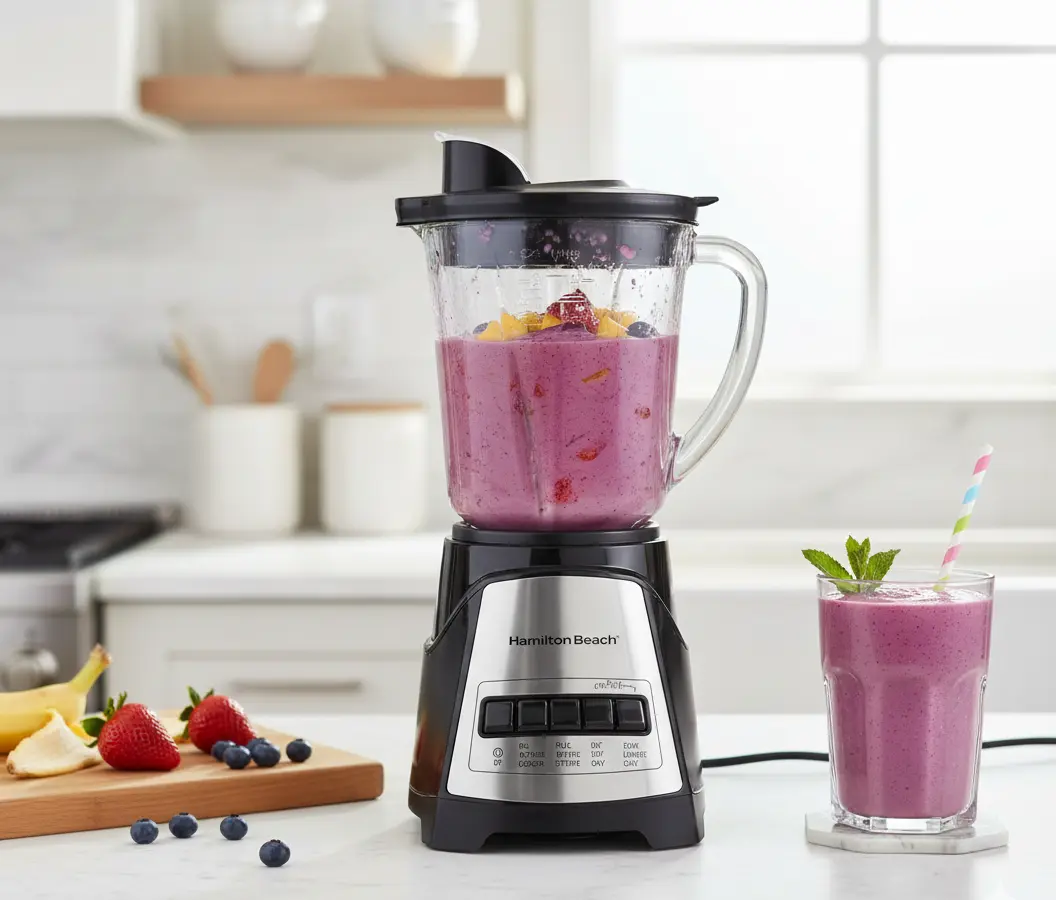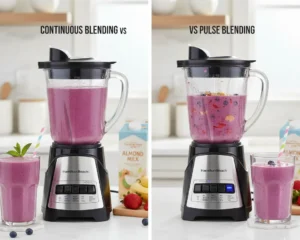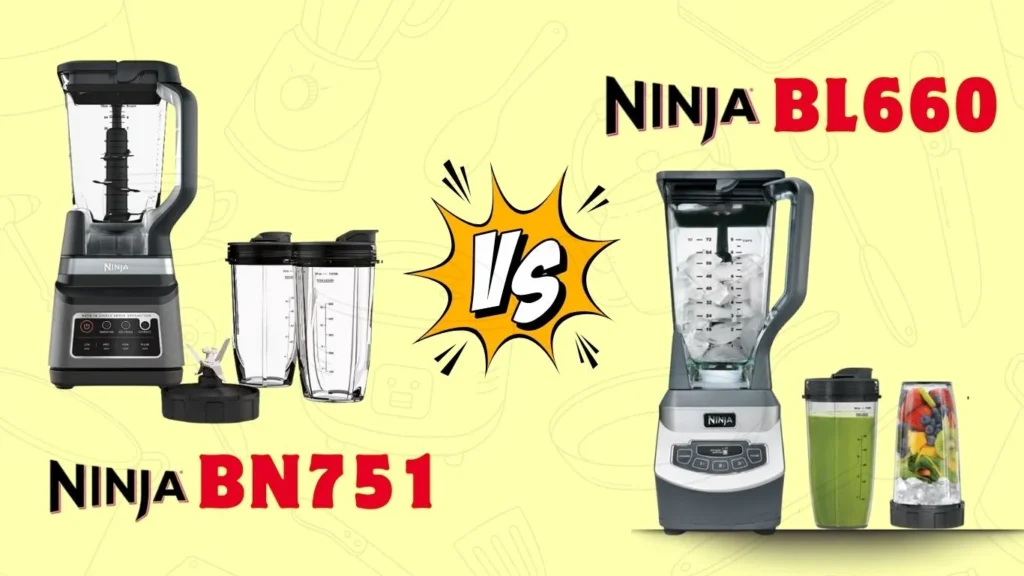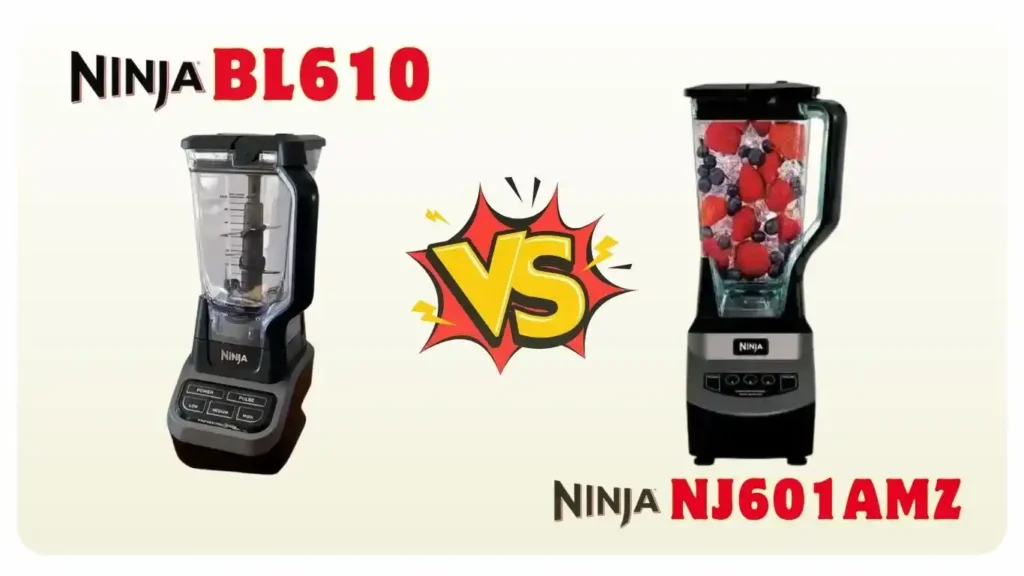Have you ever struggled to get the perfect texture from your blender? Maybe your salsa turned out too smooth, or your ice cubes didn’t crush quite right.
That’s where pulse technology comes in. This simple yet powerful feature gives you total control over your blending, allowing you to chop, crush, or mix ingredients exactly how you want. You’ll discover why pulse technology is used in blenders and how it can transform your kitchen experience—making your recipes easier, faster, and more precise.
Keep reading to learn how mastering the pulse function can unlock new possibilities for your cooking and blending tasks.

Why Pulse Technology is Used in Blender?
The pulse function in a blender offers a simple yet powerful way to control blending. It lets you blend in short, controlled bursts. This helps to achieve the right texture without over-processing the ingredients. Using pulse, you can chop, crush, or mix with precision. It is especially useful for tasks that need careful handling of ingredients.
How Pulse Function Works in a Blender
The pulse function works by running the blender motor only while you press the button. Each press sends a quick burst of power to the blades. This stops the blades immediately when you release the button. It gives you full control over how long the blender runs. You can watch the mix and stop exactly when you reach the desired texture.
Short bursts help to break down ingredients gently. This prevents turning everything into a smooth paste. The pulse action is great for chopping nuts, crushing ice, or mixing chunky salsas. It also helps to move ingredients closer to the blades before full blending.
Pulse vs Continuous Blending: Which Is Better for Texture and Control?
Continuous blending runs the blender without stTop Benefits of Pulse Technology in Blendersopping until you turn it off. It is good for making smooth purees and liquids. The blender runs at a steady speed, breaking down everything evenly.
Pulse blending lets you control the process step-by-step. It avoids over-blending and keeps some texture in the mix. This method is better for recipes that need chunkiness or uneven pieces. Pulse blending also protects delicate ingredients from turning into mush.
In short, continuous blending is for smooth results. Pulse blending is for controlled texture and chopping. Both functions have their place in the kitchen, depending on the task—especially when you make protein shakes in a blender.

Top Benefits of Pulse Technology in Blenders
Pulse technology in blenders offers key advantages for better control and texture. It allows short bursts of power, letting you blend ingredients precisely. This avoids turning everything into a smooth puree, which is important for many recipes. Below are some main benefits of using pulse technology in your blender.
1. Precise Texture Control for Professional Results
Pulse mode helps achieve the perfect texture. It lets you chop or mix ingredients without over-processing. You can create chunky salsa or coarse crumbs easily. Each pulse moves ingredients just enough, so you keep the texture you want. This control improves your cooking results.
2. Preventing Over-Blending and Preserving Food Quality
Over-blending can ruin the texture of many dishes. Pulse technology stops this by blending in short bursts. You can check the mixture between pulses to avoid turning it too smooth. It helps keep whole pieces in salads or dips. This feature saves time and ingredients.
3. Efficient Ice Crushing for Smooth and Refreshing Drinks
Pulse mode is great for crushing ice quickly. The bursts of power break ice cubes into small pieces. It prevents the motor from overheating by not running continuously. This makes frozen drinks smooth and refreshing. Ice crushing becomes easier and safer with pulse technology.
When to Use Pulse Function on a Blender
The pulse function in a blender gives you control over the blending process. It works by delivering short bursts of power. This lets you blend ingredients precisely without over-processing. Knowing when to use pulse helps you get the right texture for your recipe.
1. Chopping Ingredients Evenly Without Over-Blending
Pulse is perfect for chopping ingredients coarsely. Use it for nuts, crackers, or vegetables. Short bursts chop without turning food into a paste. This method keeps pieces uniform and avoids over-blending.
2. Maintaining Chunky Textures in Salsas and Salads
Some recipes need chunks instead of smooth blends. Pulsing helps keep pieces intact in salsas or fruit salads. It stops the blender before everything turns into a puree. This way, you get the right texture every time.
3. Starting Tough Blends Like Nuts or Frozen Fruits Easily
Pulse helps move tough or sticky ingredients toward the blades. It breaks up large pieces gently before full blending starts. This prevents the motor from stalling and mixes ingredients evenly.
4. Adding Finishing Touches for Perfect Texture Control
Use pulse at the end of blending to fine-tune texture. Quick bursts smooth the mixture slightly without losing texture. It’s useful for dips or sauces that need a little blending but still have some body.
How to Use Pulse Function Effectively
Using the pulse function effectively is key to getting the best results from your blender. It allows you to control the blending process in short bursts. This helps you achieve the right texture without over-blending. Here is how to use the pulse feature properly.
Understanding the right way to hold and release the button, checking the consistency, and timing your bursts can make a big difference in your blending tasks.
Step 1: Hold and Release the Pulse Button Correctly
Press the pulse button firmly to start the blender. Keep it held down for a short burst of power. Releasing the button stops the motor immediately. This gives you control over how much blending happens. It prevents over-processing your ingredients. Use quick, controlled presses for best results.
Step 2: Check Consistency After Each Pulse
After each pulse, stop and check the texture of your ingredients. This helps you see if you need more blending. If the pieces are too large, pulse again. If the texture is right, stop pulsing. This step ensures you get the exact result you want. It avoids turning chunky mixtures into smooth purees.
Step 3: Master the Timing of Each Pulse Burst
Use short bursts of about one to two seconds. This timing prevents the blades from running too long. Long pulses can over-blend and change the texture. Keep your bursts steady and even. This way, your ingredients blend evenly without losing their shape. Adjust the timing depending on the task, like chopping or crushing ice.

Pulse Technology In Popular Blenders
Pulse technology is a key feature in many popular blenders. It offers precise control over blending with short bursts of power. This helps to achieve specific textures, such as chunky salsa or coarse crumbs. Pulse prevents over-blending and allows for crushing hard items like ice. Several well-known blender brands include pulse technology to enhance user experience and versatility.
Ninja Blender
Ninja blenders use pulse technology for quick, controlled bursts. This helps chop ingredients without turning them into mush. The pulse button allows users to crush ice efficiently. It also helps move stubborn ingredients toward the blades. Ninja’s pulse function makes blending tasks easier and more precise.
Vitamix Models
Many Vitamix models feature pulse technology for better texture control. Users can manually start and stop the blender for short bursts. This prevents over-processing and keeps chunks intact. Vitamix pulse also helps finish blends by smoothing mixtures slightly. It is ideal for recipes that need varied textures.
Kitchenaid Blenders
KitchenAid blenders include pulse mode for versatile blending. Pulsing allows quick bursts of power to chop or crush. It is useful for recipes requiring a rough blend. The pulse button also helps clear stuck ingredients. KitchenAid’s pulse technology adds precision and control to blending.
Pulse vs Other Blender Settings
The pulse function in blenders offers a unique way to control blending. It delivers short bursts of power for precise texture control. This method helps achieve specific results that other settings cannot match. Understanding how pulse compares to other settings is key to using your blender effectively.
Pulse Vs Puree
Puree blends ingredients continuously until smooth. It removes all chunks and creates a uniform texture. Pulse breaks ingredients into smaller pieces without fully blending them. It keeps some texture and prevents over-processing. Use pulse for coarse chopping, and puree for smooth sauces or soups.
Pulse Vs Ice Crush
Ice crush is designed specifically for breaking down ice quickly. It uses a steady, strong power to crush ice cubes into small pieces. Pulse offers more control by crushing ice in short bursts. This prevents overheating and avoids turning ice into slush. Pulse is better for controlled crushing and uneven ice texture.
Pulse Vs Continuous Speed
Continuous speed runs the blender non-stop at a set pace. It is ideal for fully blending or mixing ingredients evenly. Pulse stops and starts the motor manually. This gives you control over the texture and blending time. Pulse is useful for recipes needing chunkiness or uneven blending. Continuous speed is best for smooth, consistent results.
Frequently Asked Questions
What Is The Use Of Pulse In Blender?
The pulse function delivers short bursts of power for precise control. It chops ingredients, crushes ice, and prevents over-blending. Use it to maintain texture and handle tough items without turning them into puree.
What Is The Difference Between Pulse And Puree?
Pulse uses short bursts of power to chop or crush ingredients with texture. Puree blends ingredients smoothly into a thick, uniform consistency.
What Does Pulse Do On A Food Processor?
The pulse function delivers short bursts of power, letting you control chopping, prevent over-processing, crush ice, and achieve desired textures.
What Does The Pulse Button Do?
The pulse button delivers short, controlled bursts of power. It chops, crushes ice, and prevents over-blending for precise textures.
What Is The Pulse Function In A Blender?
The pulse function gives short bursts of power for better control over blending texture.
Final Thoughts: Why Pulse Technology Makes Blenders More Effective
Pulse technology gives you control over blending textures. It helps chop ingredients without over-processing them. You can crush ice quickly using short bursts. Pulsing prevents turning chunky mixtures into purees. It also moves tough ingredients closer to blades. Using pulse makes blending more precise and efficient.
This simple feature improves your kitchen experience. Try pulsing to get the perfect texture every time.

Hi, I’m Joshua Miller, a U.S.-based food lover, review writer, and Co-founder of KitchenWink.com. I hold a Bachelor of Science in Food Science and Culinary Technology, and for over five years I’ve been testing kitchen gadgets like air fryers, blenders, and other cooking tools.
I’m also a home cook, so every product I review is tried in real kitchens—not just in theory. My reviews are based on real results, simple fixes, and tips that anyone can use. With both formal training and hands-on testing, I make sure my advice is clear, honest, and practical.
My goal is simple: to help home cooks choose the right tools and make cooking easier every day.




